Occupational environment monitoring at the factory producing silk
99,000 ₫
Note: The above price is calculated for one sample, the price may fluctuate depending on the area of the environment to be monitored and the movement of the market. For more accurate price support, please refer to the quotation table or contact directly with our consulting staff.
Environmental monitoring of silk manufacturing factories is a session of collecting, analyzing, and evaluating factors in the workplace that may be harmful to the health of workers.
Table of Contents
Toggle1. Overview of Silk Production Factories
a. What is a silk production factory?
A production factory for silk is a manufacturing facility specializing in processing and producing silk products. Silk is a fiber obtained from silkworms, a type of insect capable of creating a cocoon. Silk is high-quality, soft, and shiny, widely used in the textile industry to produce products such as silk fabric, traditional silk dresses, silk scarves, and many other high-end fashion items.

b. Production stages in a silk production factory
The main production stages in a silk production factory include:
- Silkworm rearing: The factory raises and cares for silkworms to obtain silk from the cocoons they produce. The rearing process includes providing appropriate food and living conditions for silkworm development.
- Silk harvesting: When silkworms have completed their development and formed cocoons, the factory harvests the cocoons from the silkworm farms. The cocoons contain silk fibers and need processing to extract the silk.
- Silk processing: After harvesting, silk fibers are processed to remove impurities and clean the silk. This process includes removing the cocoons, eliminating residual materials, and bleaching the silk.
- Silk preparation: Once cleaned, silk is processed into fibers ready for weaving. These fibers can be spun into threads or prepared for textile weaving.
- Product manufacturing: Silk is used to produce products such as silk dresses, scarves, skirts, and other fashion items. This process includes weaving, cutting, sewing, and finishing the final products.

c. Types of machinery used in silk production factories
In silk production factories, various machinery and equipment are used to carry out production and processing stages. Some common machines include:
- Silkworm rearing machines: Systems for caring for and rearing silkworms to produce cocoons and harvest silk. These machines can control temperature, humidity, and lighting to create the optimal environment for silkworm growth.
- Silk harvesting machines: Equipment for collecting cocoons from silkworm farms, often with mechanisms to cut and separate silk fibers efficiently.
- Silk processing machines: Machines used to remove impurities and clean silk after harvesting, including steps like removing the cocoon, reducing impurities, and bleaching silk.
- Weaving machines: Devices to weave silk fibers into fabric. These may be manual or automatic machines, depending on the factory’s scale and production capacity.
- Printing and finishing machines: Used in the production of silk products such as dresses and scarves for printing, cutting, sewing, and final finishing of embroidered silk products.
- Quality inspection machines: Machines to check the uniformity, durability, and quality of silk fibers and final silk products. They may include tensile strength testers, colorimeters, and fabric elasticity testers.

d. Occupational diseases for workers in silk production factories
Workers in silk production factories may be exposed to certain factors that can lead to occupational diseases. Common occupational health issues include:
- Respiratory diseases: Workers may be affected by silk dust and other fine particles that irritate and obstruct the respiratory system, leading to bronchitis, pneumonia, and respiratory allergies.
- Skin diseases: Continuous exposure to silk and processing chemicals can cause skin irritation, dermatitis, allergic reactions, and other skin problems. Chemical exposure may cause severe conditions such as eczema and contact dermatitis.
- Musculoskeletal disorders: Jobs requiring physical effort and repetitive movements may result in cervical spine degeneration, arthritis, and joint pain.
- Vision problems: Workers may experience eye fatigue, dryness, inflammation, and other vision issues from working in poor or harsh lighting conditions.
- Mental health issues: Jobs in silk production can cause stress and psychological pressure due to the need for precision and patience, leading to stress, anxiety, and depression.
To ensure safety and health protection, occupational safety measures and compliance with workplace health regulations are essential in silk production factories.

e. Popular types of silk on the market
On the market, several types of silk are commonly used in the silk production industry:
- Natural silk: Collected from wild silkworms, it is high-quality, soft, and durable. Used for luxury and premium silk products.
- Farmed silk: Harvested from farmed silkworms, it has consistent quality and is widely used in industrial silk production.
- Silk waste: Extracted from unused silk fabrics or production scraps, recycled for products like recycled fabrics, mattresses, pillows, and decorative items.
- Silk fabric: High-quality silk used to create luxury and premium fashion, interior décor, and traditional art products.
- Blended silk: Sometimes combined with other fibers such as cotton, synthetic, or artificial fibers to create products with specific technical or functional properties.
2. Overview of Occupational Environment Monitoring Services
a. What is occupational environment monitoring in silk production factories?
Occupational environment monitoring (or workplace environment measurement) in silk production factories involves collecting, evaluating, and analyzing indicators of workplace environmental factors to implement timely measures, minimize environmental harm to workers’ health, and prevent occupational diseases. Monitoring is mandatory for all silk production factories.
This monitoring is crucial for protecting and improving workers’ health, as labor is the core resource generating profit for the company. Workers exposed to hazards exceeding permissible limits are at risk of health problems and occupational diseases.
REGISTER FOR OCCUPATIONAL ENVIRONMENT MONITORING SERVICE
b. Nam Viet’s occupational environment monitoring program
Nam Viet’s occupational environment monitoring program is developed by engineers specializing in occupational safety and environmental protection. The program uses modern measurement methods to monitor air, water quality, microclimate, physical factors, and dust in workplaces. It is a key initiative for ensuring a safe working environment and protecting workers’ health.
Additionally, Nam Viet’s program plays a vital role in researching and developing new solutions to improve workplace environment quality. With the dedication and professionalism of its monitoring experts, Nam Viet’s proprietary program represents a breakthrough in occupational safety and environmental management in Vietnam.

c. Standardization in workplace environment measurement procedures
Standardization in Nam Viet’s measurement procedures is crucial for ensuring accuracy and reliability. The program follows recognized standards and procedures from the Ho Chi Minh City Department of Health, ensuring that collected data can be reliably used to assess workplace environments and make decisions to protect workers’ health.
These standardized procedures are carried out by highly qualified monitoring experts with extensive experience, giving managers and specialists confidence in Nam Viet’s results for informed decisions regarding worker health and environmental protection.
By applying standardization in measurement procedures, Nam Viet demonstrates its commitment to a safe working environment and contributes to improving occupational safety and environmental management in Vietnam.
d. Reporting results of silk factory environment monitoring
Monitoring results are prepared according to Form No. 04, Appendix III of Decree 44/2016/ND-CP and prepared in two copies: one sent to the labor facility that contracted the monitoring service and one retained by the monitoring organization.
According to law, monitoring results are stored indefinitely.

e. Frequency of occupational environment monitoring as required by law
According to Clause 2, Article 18 of the Law on Occupational Safety and Hygiene 84/2015/QH13, employers must conduct workplace environment monitoring to assess harmful factors at least once a year.
f. Deadline for submitting monitoring results according to law
Reports must be submitted before December 31 each year. Enterprises at production facilities are required to submit occupational environment monitoring results to the local Department of Health where the facility has its headquarters and where workers are employed.
When changes occur in technology, production processes, or upgrades that may introduce new hazards, enterprises must update occupational hygiene records to include the harmful factors requiring monitoring.
g. Penalties for violations of occupational environment monitoring by employers
According to Article 27 of Decree No. 12/2022/ND-CP dated January 17, 2022, governing administrative penalties in labor, social insurance, and Vietnamese workers working abroad under contract:
- Clause 2: A fine of VND 2,000,000 – 5,000,000 for employers who do not publicly disclose monitoring results and hazard assessment at the workplace to employees immediately after results are available.
- Clause 3: A fine of VND 20,000,000 – 40,000,000 for employers who fail to carry out workplace environment monitoring to control health hazards as required by law.
- Clause 4: A fine of VND 40,000,000 – 60,000,000 for employers who collude with monitoring organizations to commit fraud in monitoring activities, but without criminal liability.
3. Harmful environmental factors for workers in silk production factories
Workers in silk production factories may be exposed to several harmful environmental factors. The following are potential hazards that could affect employees in the silk production industry:
- Dust: The silk production process can generate dust from silk fibers and processing activities. Silk dust may irritate and damage the respiratory tract when inhaled, causing issues such as bronchitis, pneumonia, and respiratory allergies.
- Chemicals: During silk processing, chemicals such as detergents, softeners, dyes, and stabilizers may be used. Exposure to these chemicals can cause skin irritation, dermatitis, allergic reactions, and other health problems.
- Temperature and humidity: Certain silk production stages require specific temperature and humidity levels to produce high-quality products. However, excessively hot or humid work environments can cause discomfort and challenges for workers.
- Noise: Some machinery in silk production factories can generate significant noise. Continuous and loud noise may affect workers’ hearing and cause psychological stress.
- Lighting: The working environment in silk factories may have harsh lighting or insufficient natural light. Inadequate lighting can cause eye strain, reduce concentration, and increase visual fatigue.
REGISTER FOR OCCUPATIONAL ENVIRONMENT MONITORING SERVICE
4. Measures to improve the working environment in silk production factories
To improve the working environment in silk factories and protect workers’ health, the following measures can be applied:
- Ventilation and dust extraction systems: Ensure adequate ventilation in the factory and use effective dust extraction systems to reduce silk dust in the air.
- Training and guidance: Train employees on safe work procedures, including proper use of personal protective equipment, safe chemical handling processes, and accident prevention measures.
- Use of personal protective equipment (PPE): Ensure workers are fully equipped with PPE such as masks, gloves, goggles, protective clothing, and anti-static shoes to protect against direct contact with silk dust and chemicals.
- Temperature and humidity control: Maintain a comfortable and appropriate temperature and humidity level to prevent negative health effects and improve labor productivity.
- Waste management: Properly handle waste from the silk production process in compliance with environmental regulations to avoid negative impacts on the environment and human health.
- Equipment inspection and maintenance: Periodically inspect, maintain, and clean machinery, ventilation, and dust extraction systems to ensure effective operation and reduce the risk of malfunctions.
- Health monitoring: Conduct regular health check-ups for workers to detect early signs of occupational diseases and implement appropriate prevention and treatment measures.
- Rest and stress reduction: Ensure workers have sufficient breaks and opportunities to reduce stress during work to maintain good health and high productivity.
- Periodically conduct occupational environment monitoring in factories to collect and analyze harmful factors affecting workers, and adjust measures to reduce risks and prevent occupational diseases.
5. Benefits of periodic monitoring in silk production factories
An Toan Nam Viet provides businesses with excellent benefits when using occupational environment monitoring services according to Decree 44/2016/ND-CP on managing and controlling harmful factors in the workplace affecting employees.
- Businesses can proactively control harmful factors in workshops or factories.
- Receive recommendations on measures to reduce harmful factors and improve workplace quality.
- Indirectly protect human resources, a key factor in business development.
- Reduce the harmful impact of occupational diseases on human health, lowering future treatment costs.
- Improve worker health, ensuring product quality and maintaining production output.
- Comply with labor safety laws and avoid legal risks.
- Enhance credibility and professionalism in all aspects, elevating the company brand.
Nam Viet’s environmental monitoring service is a solution to reduce occupational disease risks, contributing to a clean and high-quality working environment.

6. National occupational environment monitoring center
Occupational environment monitoring center of Nam Viet is a professional unit for supervising and measuring workplace environmental quality across all provinces in Vietnam. With a team of experienced monitoring specialists, the center uses modern measurement equipment to ensure accuracy and reliability.
In addition to monitoring services, the center assists clients in planning, managing, and tracking workplace environmental issues. With the motto “customer-centered,” the center prioritizes customer satisfaction, meets all client needs, and is committed to providing the best solutions for businesses.
REGISTER FOR OCCUPATIONAL ENVIRONMENT MONITORING SERVICE
With investments in technology, equipment, and human resources, Nam Viet’s monitoring center has become one of the most reputable units in occupational environment monitoring in Ho Chi Minh City, with the following objectives:
- We always value our brand reputation and service quality.
- We provide clients with the best and most suitable solutions possible.
- Alongside a team of experienced Masters and Engineers, committed to environmental protection and business benefit.
- At Nam Viet Environmental Monitoring, companies receive professional service from field experts and the best cost advantages.
The occupational environment monitoring process at Nam Viet includes the following basic steps:
- Before conducting monitoring, our company ensures all equipment is calibrated according to legal regulations.
- Follow the occupational environment monitoring procedures committed to the Department of Health accurately and fully.
- Report monitoring results honestly to employers.
- If monitoring results indicate unsafe conditions, Nam Viet provides corrective solutions, and the workplace implements the following:
- Implement measures to improve working conditions, minimize harmful factor impacts, and prevent occupational diseases.
- Conduct health examinations to detect occupational and related diseases early for workers in unsafe environments.
- Provide in-kind compensation to workers according to labor law.

7. Occupational environment monitoring quotation
To help businesses conduct professional and effective occupational environment monitoring, Nam Viet provides clients with a quotation for occupational environment monitoring services with quality and reasonable costs.
- Our quotation provides detailed pricing information for the monitoring services we offer, including costs related to travel, measurement, analysis, and reporting. Clients can trust the accuracy and reliability of the monitoring reports we provide.
- We commit to offering competitive and reasonable prices in the market and are always ready to provide quick and professional advice for any inquiries regarding monitoring services.
- With Nam Viet’s monitoring quotation, clients can easily select service packages suitable to their needs. We are committed to delivering the highest satisfaction with professional service quality.
No comments yet

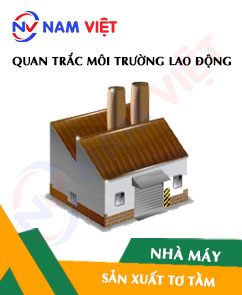
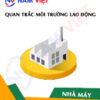
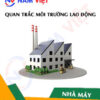

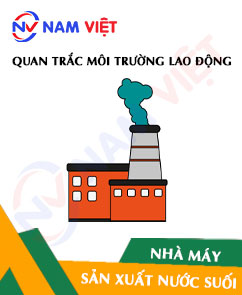



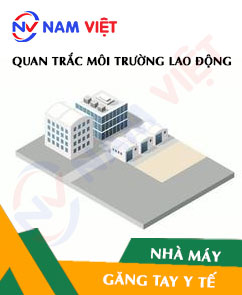
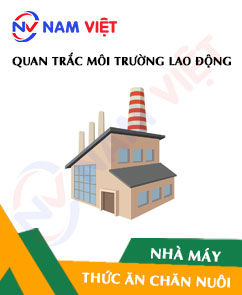

Review Occupational environment monitoring at the factory producing silk
There are no reviews yet.